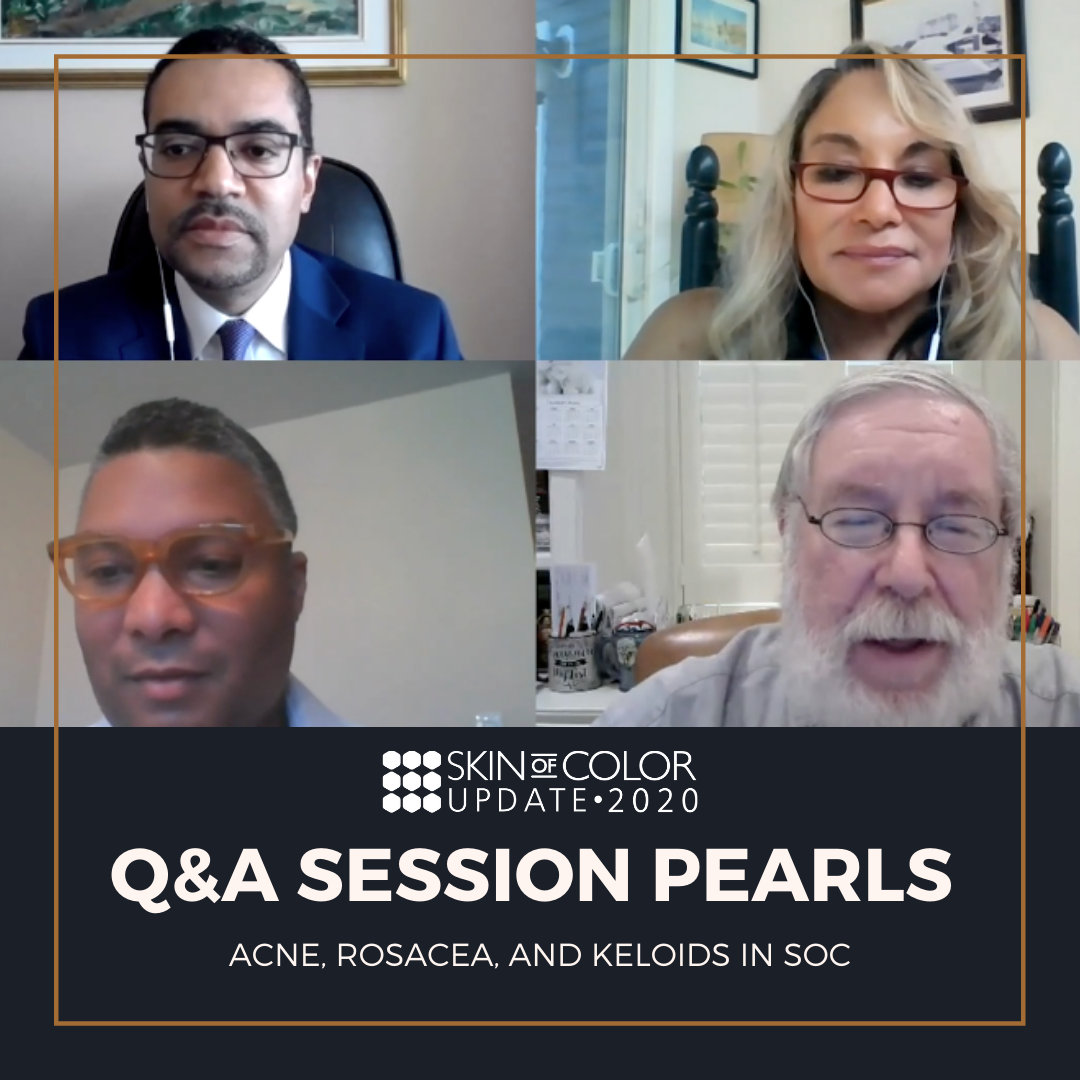One of my favorite aspects of attending conferences is the opportunity to ask respected experts in the field clinically relevant questions that I can take back to directly help my patients. I was really looking forward to attending the 2020 Skin of Color Update conference in person, but due to the ongoing COVID-19 pandemic, it was moved to a virtual format. I wondered if attending a virtual conference would allow the same level of audience engagement as a traditional conference would.
Thankfully, due to the many excellent speakers and quality of the content presented, this was not an issue and many exceptional questions were generated at the conclusion of the first general session. The first general session was primarily focused on three key topics: Acne, Rosacea, and Keloids in skin of color. This post will summarize the key pearls that I gleaned from this Q&A session.
Rosacea Pearls
-
- Granulomatous rosacea (GR) and sarcoid are difficult to distinguish!
- GR tends to favor the periocular areas; the patient may also have more classic lesions of rosacea such as papules and pustules which would favor GR.
- The morphology of sarcoidal papules and plaques tend to have a plateau in contrast to GR which are more domed papules.
- Have a low threshold of suspicion and know when to biopsy. Send the tissue to a dermatopathologist over a general pathologist whenever possible to make this difficult diagnosis.
- Treatment for GR
- Topical treatments are generally ineffective.
- Dr. Rosen recommends doxycycline or minocycline at full dose +/- intralesional Kenalog (ILK) at 3.5-5mg/ml concentration for larger lesions.
- Rhinophyma Treatment
- In mild cases, Fractionated CO2 + Topical triamcinolone 0.1% cream works well.
- Otherwise, standard excision using a scalpel + meticulous hemostasis using electrosurgery is needed. This can be followed by the 2970nm laser for hemostasis and further shaping on a case by case basis.
- Key Point: Set patient expectations BEFORE you operate! The nose will never be completely normal once phymatous changes have occurred, but the goal is to restore the normal anatomical contours of the nose.
- Granulomatous rosacea (GR) and sarcoid are difficult to distinguish!
Acne Pearls
-
- Retinoids are the foundation for all acne treatment unless there is a contraindication to their use. They treat comedones as well as post-inflammatory hyperpigmentation.
- Azelaic acid can also be used but more as a second-line agent to topical retinoids. Azelaic acid can also help with post-inflammatory hyperpigmentation.
- Topical minocycline shows promise in treating inflammatory acne lesions and there have been no reports of systemic side effects (e.g., Lupus, DRESS syndrome) or pigmentation side effects with its use.
Keloid Pearls
-
- The maximum dose of ILK that can be administered safely at one time is 40mg in one session. Dr. Jagdeo injects small aliquots of 0.1mls along the keloid.
- Following keloid excisions, inject 10mg/ml of ILK for a total of 1-3ml depending on the size of the keloid. You can follow this up with the 1064nm laser or repeat ILK as indicated.
- For severe or recalcitrant lesions, consider a multi-disciplinary approach involving Plastic Surgery and Radiation Oncology.
- One of the panel experts, Dr. Maritza Perez, published a paper utilizing the 300 microsecond 1064nm Nd:YAG laser. She briefly explained her protocol for treating these patients as follows:
- Week 1: Injection of the keloid with 10mg/ml ILK for a total of 3-6ml depending on the size of the lesion.
- Week 2: Treatment with the 300 microsecond 1064nm Nd:YAG laser at a fluence of 13-16 J/cm2, using a 5mm spot size. Treatment is done in a “spray-painting” technique over the entire lesion for 2000 pulses.
- This is repeated weekly at weeks 3-6 with subsequent increases of the fluence by 1 J/cm2 with a max fluence of 18 J/cm2.
- At week 7, the keloid is again injected with 10mg/ml ILK, and follow-up is continued at regular intervals to repeat treatment as clinically indicated.
- Key Point #1: Start gently, especially in new patients and new keloids. In general, it is wise to start at 10mg/ml and work up from there to prevent unwanted side effects.
- Key Point #2: You can use cryotherapy to “spray paint” the keloid with a diffuse superficial spray for 3-5 seconds prior to treatment with ILK. The resulting edema allows the injection to be performed easier and provides some local anesthetic benefit as well. Anecdotally, I have personally tried this method since attending this session and my patient noted a significant reduction in discomfort in the keloids that I pre-treated with liquid nitrogen.
-
- Key Point #3: Dr. Jagdeo uses topical Tacrolimus 0.1% twice a day for 6-8 weeks to treat intralesional steroid-induced hypopigmentation.
I found this Q&A session to be extremely valuable and practical in everyday practice. While I do miss the comradery of face-to-face interactions at live conferences, I am grateful to have learned from these leading experts in skin of color dermatologic care in such an interactive format!
Stay tuned for additional Q&A session summaries packed with even more practical pearls!
The above article was written by Dr. Sang Kim, Derm In-Review Advisory Council Member, and represents his interpretation of the information presented at the 2020 Skin of Color Update conference during a faculty Q&A session with the audience. Participating faculty included: Drs. Andrew Alexis, Jared Jagdeo, Ted Rosen, and Maritza Perez.
Did you enjoy this article? Find more on Skin of Color here.

